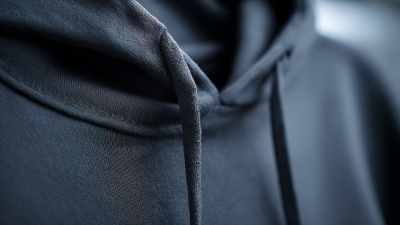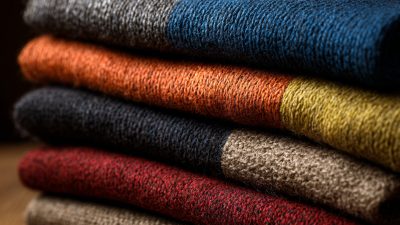In recent years, the fashion industry has increasingly prioritized sustainability, leading to innovative materials and design approaches that minimize environmental impact. One such innovation is the use of Thin Hoodie Fabric, which has emerged as a promising alternative for eco-conscious consumers. According to a report by the Sustainable Apparel Coalition, the fashion sector is responsible for approximately 10% of global carbon emissions, making the transition to sustainable materials imperative.

Thin Hoodie Fabric not only offers breathability and comfort but also reduces energy consumption in production by up to 30% compared to traditional materials. Additionally, the lightweight nature of this fabric allows for efficient shipping and reduced resource usage. As consumers become more aware of their fashion choices' ecological footprints, Thin Hoodie Fabric represents a crucial step towards a more sustainable future, offering both style and environmental responsibility.
Thin hoodie fabrics have garnered attention in the realm of sustainable fashion due to their eco-friendly properties. These materials are often crafted from lightweight, breathable fibers that offer comfort without compromising durability. Commonly made from organic cotton, recycled polyester, or Tencel, these fabrics reduce the environmental footprint associated with traditional hoodie production. By opting for thin hoodie fabrics, consumers not only enjoy a stylish garment but also contribute to a more sustainable clothing industry.
Additionally, the production processes for thin hoodie fabrics tend to prioritize sustainability. Manufacturers are increasingly adopting practices that minimize water usage, energy consumption, and chemical treatments, making these fabrics a more responsible choice. The versatility of thin hoodies allows them to be worn across seasons, reducing the need for multiple bulky garments, thus promoting a minimalist wardrobe. As awareness of fashion's environmental impact grows, choosing thin hoodie fabrics represents a progressive step towards a more eco-conscious lifestyle.
Thin hoodies are gaining popularity as a sustainable option in modern fashion, particularly because they often utilize lighter, eco-friendly materials that reduce overall fabric waste. According to recent industry reports, the demand for lightweight, sustainable fabrics has surged, with more brands opting to incorporate recycled materials and lower-impact fibers. For instance, choosing fabrics like organic cotton and Tencel not only decreases environmental impact but also enhances breathability and comfort, making them ideal for layering or solo wear in various climates.
As consumers become more conscious of their clothing choices, the trend toward thin hoodies aligns with the broader movement towards sustainability in the fashion industry. Research indicates that nearly 60% of consumers are now prioritizing sustainable practices when purchasing clothing. This shift encourages brands to innovate and offer designs that are both stylish and environmentally friendly. By selecting thin hoodies made from sustainable fabrics, consumers can make a conscious choice for their wardrobe, contributing to a healthier planet while enjoying the latest trends in comfort and style.
Thin hoodies have become a staple in sustainable fashion, providing versatility while minimizing textile waste. According to a report by the Sustainable Apparel Coalition, lightweight fabrics like thin hoodie materials typically use less energy and water during production compared to heavier alternatives. This shift not only reduces the environmental impact but also aligns with the increasing demand for eco-friendly clothing among consumers, with 73% expressing a preference for sustainable brands in a recent survey by McKinsey & Company.
Styling thin hoodies for any season is easy with a few strategic choices. In spring and fall, layering a thin hoodie over a classic button-up or under a denim jacket creates a balanced look that’s both comfortable and chic. During the summer, opt for breathable cotton or linen blends to ensure comfort without sacrificing style. Pairing a light hoodie with high-waisted shorts and sneakers can create a casual yet polished outfit. For winter, thin hoodies can serve as a perfect base layer beneath heavier outerwear, allowing for warmth without bulkiness, making them an ideal choice for those looking to maintain style through various temperature changes.

Caring for thin hoodies is essential for ensuring their longevity and promoting sustainable fashion choices. To maintain these lightweight garments, it's crucial to follow a few simple care instructions. Washing in cold water and opting for a gentle cycle can help preserve the fabric and colors, reducing wear over time. Moreover, air drying instead of using a dryer extends the life of the hoodie while minimizing energy consumption, aligning perfectly with environmentally conscious practices.

Additionally, proper storage plays a significant role in maintaining the integrity of thin hoodies. Folding them neatly and avoiding long-term hanging can prevent stretching and deformation. When it comes to stain removal, opting for eco-friendly, biodegradable detergents ensures that our care routines do not harm the planet.
Regularly inspecting these garments for signs of wear, such as loose threads or small tears, allows for timely repairs, thus extending their usable life and reinforcing a sustainable wardrobe ethos. By focusing on maintenance, wearers can enjoy their stylish thin hoodies while actively contributing to a more sustainable fashion industry.
The future of fashion is increasingly leaning towards sustainable design choices, and one of the key innovations is the embrace of thin fabrics, particularly in hoodies. Research from the Global Fashion Agenda indicates that the fashion industry is responsible for 10% of global carbon emissions, highlighting the urgent need for more sustainable practices. Thin hoodie fabrics, often made from organic cotton or recycled polyester, offer a lighter footprint both in production and transportation. By using less material, brands can significantly reduce resource consumption and waste.
Moreover, thin fabrics align perfectly with the rising consumer demand for versatility and comfort. A report by McKinsey & Company shows that 67% of consumers want brands to work towards sustainable practices. Lightweight hoodies not only cater to this desire but also meet the requirements for year-round wear, making them a staple in any sustainable wardrobe. As brands adopt these materials, they're not only enhancing their eco-credentials but also tapping into a market that increasingly values sustainability, comfort, and style.





